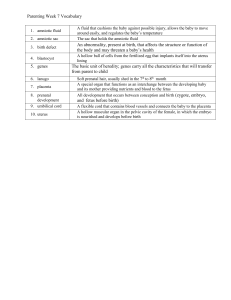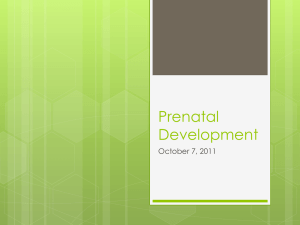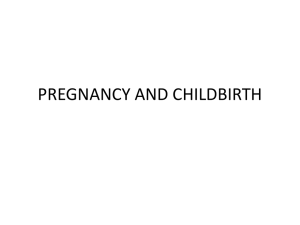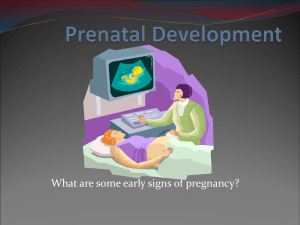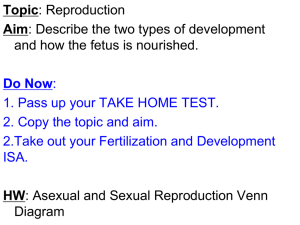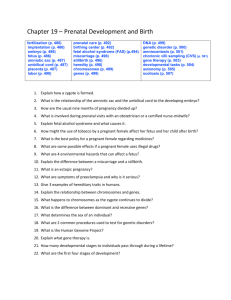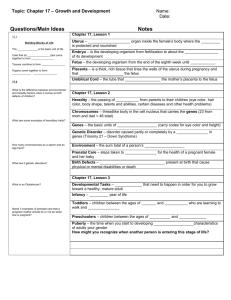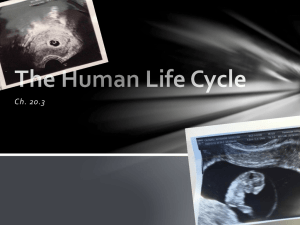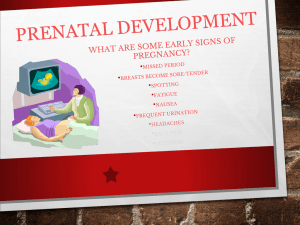UNIT 3 BELL QUIZZES BELL QUIZ Unit 3 #1 Prenatal Development
advertisement
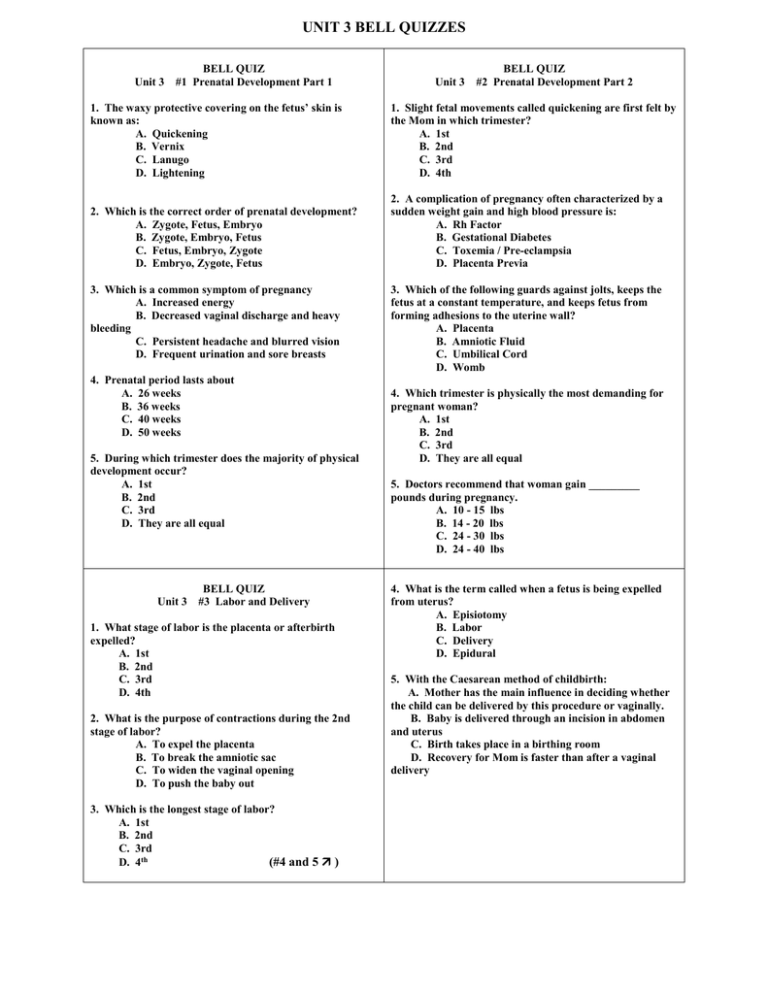
UNIT 3 BELL QUIZZES Unit 3 BELL QUIZ #1 Prenatal Development Part 1 Unit 3 BELL QUIZ #2 Prenatal Development Part 2 1. The waxy protective covering on the fetus’ skin is known as: A. Quickening B. Vernix C. Lanugo D. Lightening 1. Slight fetal movements called quickening are first felt by the Mom in which trimester? A. 1st B. 2nd C. 3rd D. 4th 2. Which is the correct order of prenatal development? A. Zygote, Fetus, Embryo B. Zygote, Embryo, Fetus C. Fetus, Embryo, Zygote D. Embryo, Zygote, Fetus 2. A complication of pregnancy often characterized by a sudden weight gain and high blood pressure is: A. Rh Factor B. Gestational Diabetes C. Toxemia / Pre-eclampsia D. Placenta Previa 3. Which is a common symptom of pregnancy A. Increased energy B. Decreased vaginal discharge and heavy bleeding C. Persistent headache and blurred vision D. Frequent urination and sore breasts 4. Prenatal period lasts about A. 26 weeks B. 36 weeks C. 40 weeks D. 50 weeks 5. During which trimester does the majority of physical development occur? A. 1st B. 2nd C. 3rd D. They are all equal Unit 3 BELL QUIZ #3 Labor and Delivery 1. What stage of labor is the placenta or afterbirth expelled? A. 1st B. 2nd C. 3rd D. 4th 2. What is the purpose of contractions during the 2nd stage of labor? A. To expel the placenta B. To break the amniotic sac C. To widen the vaginal opening D. To push the baby out 3. Which is the longest stage of labor? A. 1st B. 2nd C. 3rd D. 4th (#4 and 5 ) 3. Which of the following guards against jolts, keeps the fetus at a constant temperature, and keeps fetus from forming adhesions to the uterine wall? A. Placenta B. Amniotic Fluid C. Umbilical Cord D. Womb 4. Which trimester is physically the most demanding for pregnant woman? A. 1st B. 2nd C. 3rd D. They are all equal 5. Doctors recommend that woman gain _________ pounds during pregnancy. A. 10 - 15 lbs B. 14 - 20 lbs C. 24 - 30 lbs D. 24 - 40 lbs 4. What is the term called when a fetus is being expelled from uterus? A. Episiotomy B. Labor C. Delivery D. Epidural 5. With the Caesarean method of childbirth: A. Mother has the main influence in deciding whether the child can be delivered by this procedure or vaginally. B. Baby is delivered through an incision in abdomen and uterus C. Birth takes place in a birthing room D. Recovery for Mom is faster than after a vaginal delivery Bell Quizzes #4 and #5 Stages of Prenatal Development A. Period of the zygote / ovum B. Period of the embryo ___ 1. The fertilized egg is about the size of a pinhead. ___ 2. The baby begins to add fat beneath the skin. ___ 3. A sac of amniotic fluid forms. ___ 4. The baby assumes the fetal position. ___ 5. The baby begins to move ‘quickening’ occurs. ___ 6. The fertilized egg passes through the Fallopian tube. ___ 7. Bones and organs begin to form. ___ 8. Conception takes place. ___ 9. The heartbeat can be heard through a stethoscope. ___ 10. The face and limbs begin to take shape. ___ 11. The fertilized egg attaches itself to the lining of the uterus. ___ 12. The baby is upside down, with its head nestled in the mother’s pelvis. ___ 13. The unborn baby begins to suck its thumb, cough, sneeze, and yawn. ___ 14. The fertilized egg begins to grow by the process of cell division. ___ 15. Nourishment begins to pass from placenta through the umbilical cord. ___ 16. Baby has Lanugo and vernix covering the body. ___ 17. Lightening occurs. Stages of Labor A. First stage B. Second stage C. Third stage Draw a line to the diagram that represents each stage. ___ 1. Involves little or no discomfort. ___ 2. Episiotomy may be performed. ___ 3. Medication may be given to reduce discomfort. ___ 4. At the beginning of this stage, contractions are about two to four minutes apart. ___ 5. Relaxation is important to prevent muscles from tightening. ___ 6. Mother may be asked to bear down to help the baby along. ___ 7. Lasts from two minutes to half an hour. ___ 8. Baby moves down into lower pelvis and into position for birth. ___ 9. Baby is born. ___ 10. Near the end of this stage, contractions are strong and frequent. ___ 11. Longest stage of labor. ___ 12. Mother may be moved from the labor room to a separate delivery room. ___ 13. Uterus contracts to expel afterbirth (placenta, umbilical cord, amniotic sac). ___ 14. Cervix dilates and becomes thinner. ___ 15. Forceps may be used, if necessary. ___ 16. Crowning occurs. ___ 17. The show can be seen. C. Period of the fetus
